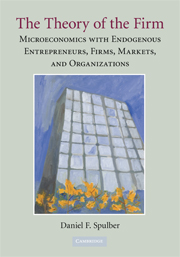 The Theory of the Firm
The Theory of the Firm Book contents
- Frontmatter
- Contents
- Preface and Acknowledgments
- Introduction
- PART I THE THEORY OF THE FIRM
- PART II THE ENTREPRENEUR IN EQUILIBRIUM
- PART III HUMAN CAPITAL, FINANCIAL CAPITAL, AND THE ORGANIZATION OF THE FIRM
- PART IV INTERMEDIATION BY THE FIRM
- PART V MARKET MAKING BY THE FIRM
- 10 The Firm Creates Markets
- 11 The Firm in the Market for Contracts
- 12 Conclusion
- References
- Author Index
- Subject Index
10 - The Firm Creates Markets
Published online by Cambridge University Press: 05 June 2012
- Frontmatter
- Contents
- Preface and Acknowledgments
- Introduction
- PART I THE THEORY OF THE FIRM
- PART II THE ENTREPRENEUR IN EQUILIBRIUM
- PART III HUMAN CAPITAL, FINANCIAL CAPITAL, AND THE ORGANIZATION OF THE FIRM
- PART IV INTERMEDIATION BY THE FIRM
- PART V MARKET MAKING BY THE FIRM
- 10 The Firm Creates Markets
- 11 The Firm in the Market for Contracts
- 12 Conclusion
- References
- Author Index
- Subject Index
Summary
Firms create and manage markets that enhance the efficiency of transactions. By creating markets, firms separate the economy's supply decisions from its demand decisions. Standing between sellers and buyers, firms coordinate their transactions. As matchmakers, firms bring buyers and sellers together. As market makers, firms operate central places of exchange, gather information about supply and demand, and adjust bid and ask prices. Firms make purchasing, sales, inventory, and production decisions that clear markets. This chapter examines the potential role of the firm as a market maker in comparison with direct exchange between consumers.
The essential contribution of firms to economic efficiency comes from the separation of decisions of sellers from the decisions of buyers. The firm offers market-making and matchmaking services that coordinate seller transactions and buyer transactions. Spulber (1999) emphasizes that by establishing transaction institutions, firms determine the market microstructure of the economy. Rather than engaging in direct exchange with each other, buyers and sellers can deal with market-making firms.
Firms enhance the efficiency of transactions by centralizing exchange. Centralization of exchange yields economies of scale in transaction technologies. Centralization of exchange allows the firm to aggregate individual supplies and to aggregate individual demands, avoiding mismatches of individual buyer demands with individual seller supplies. Market-making firms coordinate exchange between buyers and sellers by posting and adjusting prices. Market-making firms provide liquidity in financial markets and immediacy in product markets by standing ready to buy and sell, thus addressing the absence of a double coincidence of wants.
- Type
- Chapter
- Information
- The Theory of the FirmMicroeconomics with Endogenous Entrepreneurs, Firms, Markets, and Organizations, pp. 367 - 416Publisher: Cambridge University PressPrint publication year: 2009
- 1
- Cited by


